Introduction
Klaus Teuber, the designer of Catan, passed away earlier this week at the age of 70. It is hard to overstate the impact that Catan had on the design of board games, and their place in public consciousness.
But why? Was it just a case of being in the right place at the right time? There are many examples of movies, television shows, or books that capture the public imagination and are breakout viral hits. But sometimes they aren’t appreciably head and shoulders above other movies. They just happen to catch lightning in a bottle.
Was Catan one of these? Was the stage just set for a game like it to break through? Or was there something objectively better about Catan that made it the mega-hit it became?
While there’s always a healthy dose of luck with being a success, I think there are indeed a wide variety of reasons why Catan is a brilliant piece of design. Sometimes we may take them for granted, as many features were adapted for future games. For many gamers today, some of these innovations are ‘the water we swim in’, and we may take them for granted. But that doesn’t make them less innovative or instructive.
I would like to take a step back and dissect some of these key design choices, and what we can learn from them.
Fair warning - I’m going to gush. There are a few missteps in my opinion, which I will point out, but just be prepared for heaps of admiration.
The Pregame
Let’s start at the beginning of the game. The first step in a game of Catan is setting up the board, which is a mix of random tile placement with semi-random number tokens. The players then place a settlement and road, in snake draft fashion (player order for the first settlement, then reverse player order for the second).
Here’s the first innovation and incredibly smart design choice by Catan. Just about every popular board game before this had a fixed setup. Monopoly, Risk, Diplomacy, Chess, Checkers, Backgammon, Scrabble, Trivial Pursuit, Titan, Sorry!, Cosmic Encounter - In all of these games, the board setup is the same, or really close to it. Yes, in Risk maybe your armies are in different locations, but Australia will always be Australia.
Probably the most common game style with variable setup is card games. But they have a different feel than the start of Catan due to the large amount of hidden information. You usually see at most a quarter of the cards.
Catan is different. First, it’s not actually totally random. As alluded to above, the number tokens on each tile are not placed randomly. They are placed in a spiral pattern from the outside in, in a specific order, skipping the desert tile. This makes the starting point slightly different from game to game, while still preserving a reasonable distribution of the 6/8 tokens. It’s a very elegant solution to introducing minor randomness while the designer maintains control.
Often as designers, including random elements means giving up control over large swaths of the game. Wresting that control back can make setup more complex or add extra rules. For example, in Pandemic you have to set up the Infection deck by dividing it up into separate piles, and shuffling an Epidemic card into each, then stacking them on top of each other. Leacock did this to ensure a reasonable spread of Epidemic cards while not being totally predictable.
I’m not critiquing this method - I used it myself in The Expanse. But it highlights how deftly Teuber incorporates this type of controlled setup randomness, with a minimum of rules or fiddliness to the setup.
Note: Some people play with totally random number token placement. Although it is mentioned in the rules as a variant, those people are wrong. Thanks for coming to my Ted Talk
The random distribution of hexes and semi-random distribution of number tokens and ports presents the players with a very deep puzzle right at the start of the game. Where do you put those starting settlements and roads? This decision can have enormous repercussions on the entire game, and there are a lot of factors the players need to consider. Are there certain resources that will be hard to get based on their numbers? Do I want to focus on early game resources (brick / wood) or late game (sheep / rock)? Do I want to place my settlements within shouting distance of each other to try to go for Longest Road? Are there ports I want to be near based on resources I think I’ll have a lot of?
And I get starting resources based on the location of my second settlement. Does that impact where I want to place?
And what will my opponents do? Am I setting them up to be able to block me out?
No other game has done this. And honestly I would say that very few have done this since. Maybe Dominion presents players with an assortment of different card types, and you need to figure out a strategy around that. But it can develop as you go - you aren’t really committing right off the bat, like you do in Catan.
This setup is a classic example of Input Randomness - where the randomness happens first, and then you make decisions based on that. Ryan and I first raised this idea on Ludology, and I talk about Input vs Output Randomness, and other types of randomness in this video:
Of course, the production from your settlements is Output Randomness based on this initial decision. But because Settlements can’t move, this production is somewhat, in a sense, predictable over the long run. More about this in a second.
I’d also like to highlight the use of the snake draft. One of the fun things about Catan is that both ends of the draft - picking first overall or getting back-to-back picks if you’re last - feel good in their own way. It’s a great feeling to be able to take the absolute premium spot on the board, and equally great (although a different feeling) to be able to plan two selections without worrying about opponents getting in your way.
Again, the snake draft is a much sleeker way of balancing the start as opposed to, say, giving bonus starting resources to players later in the turn order. Hopefully you can appreciate that the actual method used in Catan is vastly superior, even if it doesn’t necessarily give you as much fine-tuned control over the relative strength of different start positions as resource bonuses do.
One of the cardinal rules I always stress when reviewing designs is the first-time player experience. Having this front-loaded choice of settlement placement is great for experienced players. But it forces new players to make absolutely critical decisions when they least understand the implications.
Catan, of course, got around this by having a scripted setup for new players right in the front of the rules. In fact, if you want to use the ‘standard’ variable setup described earlier, you have to go hunting for it. It’s buried towards the end of the Almanac (a separate booklet with details of many rules).
Too often games will place both ‘introductory’ and ‘standard’ rules side-by-side. This can not just cause confusion, but also lead to many groups not wanting to be ‘babied’ and jumping right into the deep end.
It is almost impossible for a group opening Catan and playing for the first time to not use the standard setup.
I’m not sure if the idea of structuring the rules this way lies with Teuber. But kudos to whomever laid it out this way.
Production and Trading
One of the hallmarks of Catan is the simultaneous production. This keeps players engaged on others’ turns. While other games prior to Catan did this (notably Crude: The Oil Game), in Catan it is completely egalitarian. In other games, including Crude, the player whose turn it is typically produces more, or has more chance to produce, as opposed to the others.
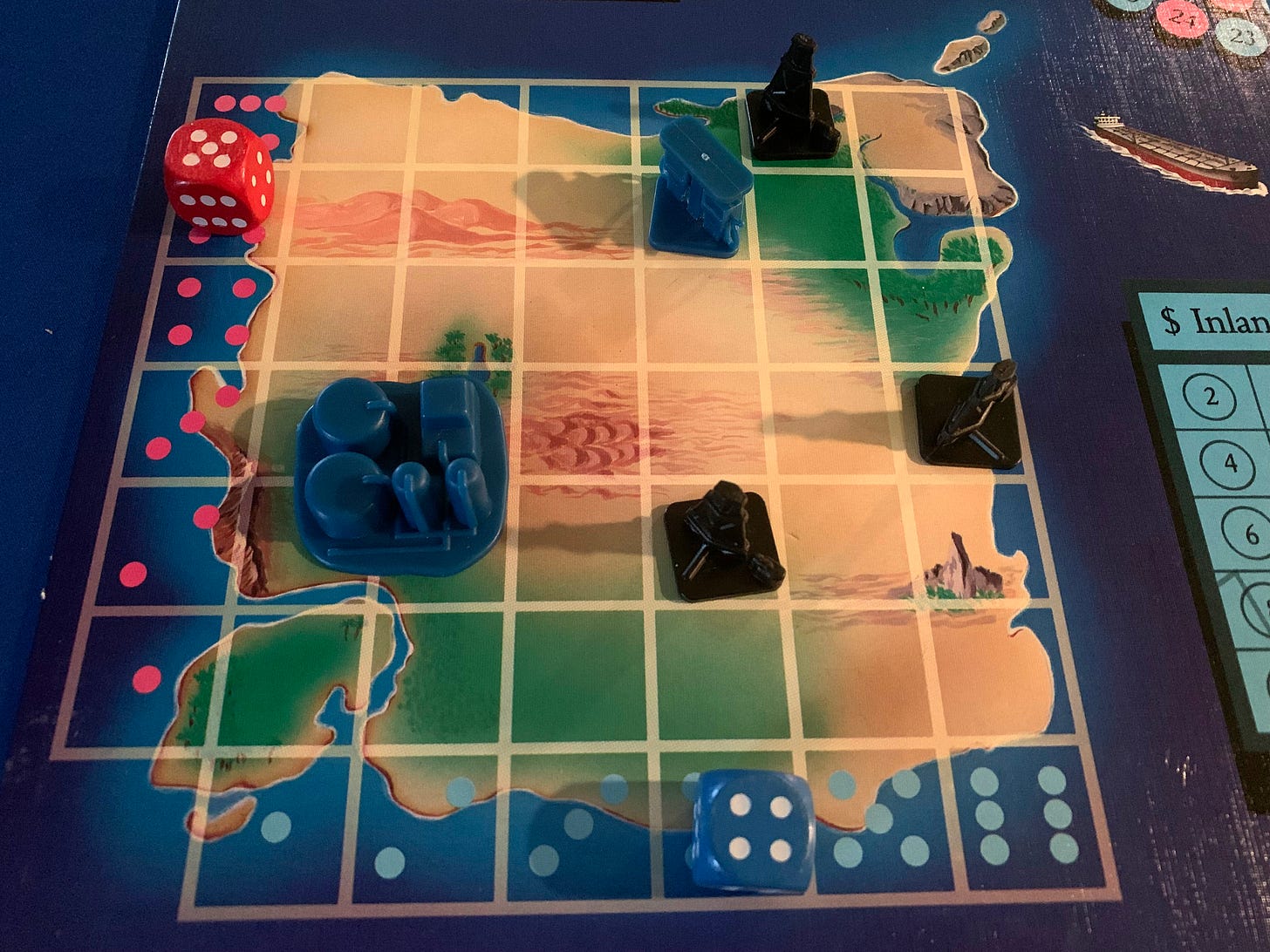
Graphic Design sidebar: The ‘dots’ on the number tokens in Catan indicating which spaces are more valuable, coupled with the red numbers on 6 and 8 do a great job of letting all players know the relative value of spaces without needing to understand the probability.
That egalitarian spirit of production is broken in the Trade phase, as the active player must be involved in all trades.
As far as I am aware, Catan was the first time this was done, and it has yet to be duplicated (although I am sure someone will correct me on this) (and several of you did - thanks! The best example of this being used in another game is the bean-trading game Bohnanza, published just two years after Catan, so it is possible its use of ‘only trade with active player’ was a case of parallel evolution). This is another fantastic design decision.
There are a few problems with trading as a mechanism - it extends play time, some players don’t like having to cajole others into trading (performative anxiety), and it can break up the social cohesion if two players are trying to negotiate one trade, and the other two are working on their own side deal.
Forcing all trades to be with the active player addresses all of these:
It reduces time for the trade phase since the number of possible trading partners is cut in half. With four players there are six possible trade partners (AB, AC, AD, BC, BD, CD). With this rule, there are only three trade partners (AB, AC, AD).
Since one player is the focus, other players come to them. Players won’t feel ‘left out’ of the proceedings.
The group is always involved in the discussions. There are no side talks.
All of these elements work together to make the Catan trading phase much more manageable than, say, trading in Monopoly, which is totally freeform.
Trading also introduces a soft ‘catch-the-leader’ mechanism, as players can try to agree to a trade embargo against someone who is far ahead or close to victory.
However, this trade embargo option doesn’t block the game, because of another smart feature - self-trade via ports. As you may recall, in Catan there are three types of trades you can make that don’t require another player. You can always trade four-of-a-kind for any resource, and if you have a settlement at a port you can either trade three-of-a-kind for any, or two of a specific resource, depending on the type of port.
Ports (and the general 4:1 trade) serve a number of purposes.
First, they circumvent the trade embargo strategy. If a player is getting frozen out of trades, they can always strive to get big enough sets together that will enable them to exchange for the resources they need.
Second, they move the game along. It is possible through a series of unfortunate rolls that certain resources are not being generated. If there was no way to exchange for those, the game could grind to a halt, which would be no fun.
Finally, they give players a reason to build towards the edge of the map. Because you gain resources from all hexes adjacent to a settlement, the most valuable will be those at the intersection of three hexes. Ports draw players to build out towards the much-less-valuable outer-hexes, which may be adjacent to only two or even a single hex. Without the ports much of the map would be pointless.
Also, that Teuber called them ‘Ports’ is incredibly thematic. They are on the water and allow for exchange of goods. It is a perfect fit, and you don’t have to teach their function more than once. They are just an incredibly nifty and seemingly effortless design feature.
While not unique to Catan, another element of trading that sets it apart from, for example, Monopoly, is that you are trading just a few non-unique commodities. In Monopoly, if you need Marvin Gardens and another player owns it, you only have one option. And if they don’t want to trade it to you, you’re just out of luck. This can lengthen (and potentially even lock up) games with unique set elements players are trying to collect. The various options for getting resources outside of trading (regular production, self-trades, development cards) softens the hard edges you often see in other trading games.
The Robber
One of the more controversial aspects of Catan is the Robber. By shutting down production on a hex, it is the single most ‘attack’ type action in the game. I appreciate that Teuber needed to do something with a roll of 7 - just having no production isn’t that much fun.
The ‘take that’ aspects of the robber are mitigated by a few rules:
The robber shuts down all settlements / cities on the hex, not just a single player (encouraging players not to put all their stuff around a single hex)
The robber must be moved when it is rolled. So it is more difficult to repeatedly victimize the same player.
When the robber is moved, a player can steal a card. This may make it more advantageous to place it so you can steal from a player that you know has a resource you need, rather than, perhaps, the leader.
Soldier development cards can move the Robber.
All of these add more texture to the robber, rather than making the choice obvious.
Another ‘fun’ feature of a robber turn is that players who have eight or more cards lose half. (As someone who has been on the receiving end of this loss too many times, I am using ‘fun’ very loosely here!) This has a few features that may not be obvious at first glance:
If a player has had a windfall series of turns, collecting lots of resources, it puts them at risk. This helps bring ‘lucky’ players back to the pack, and also encourages players to spread out onto different numbers.
Ideally it is nice to be able to build roads and a settlement all in one shot. That way there’s no risk of your desired spot getting sniped and having a road at a dead end. However, holding onto a bunch of resources creates a push-your-luck situation.
All of these are positive, but very subtle, interactions that keep the game close, and moving forward. They are the hallmark of a designer in command of their craft.
Graphic Design Sidebar: I also love that the robber pawn is sized to fit perfectly on the number token. With the number not visible, it is almost impossible to forget that the robber has shut down the hex.
Development Cards
Another I would like to touch on is the Development Cards. These are cards that can be purchased for resources, that come in three basic flavors: VP cards (worth one victory point), Soldiers, and one-time effects (in a few varieties).
While I like some of these, I think the Development cards are the weakest part of the game and have are the least innovative. Having some 1 VP cards mixed in is probably their best feature. The uncertainty this introduces about how close people are to actually winning is a great feature (although, honestly, the cards are usually very useful, so if someone is sitting on a card you can guess it’s probably a VP card. The value of a ‘bluff’ here is minimal).
The special effects (shown above) can be very swingy, although they do lead to some fun and surprising moments.
I do not like the Soldier cards and Largest Army victory points. It’s not really a ‘strategy’ you can pursue. I mean, you can buy lots of cards and hope to get soldiers. But it’s not something you can gear up for like Longest Road.
As a sidebar, I do like Longest Road. It emphasizes the building aspect of the game and gives an alternate way to get points that is within your control. It also allows for interesting plays to interrupt someone’s road (although that is one of those outlier rules that is a prickly edge case).
In general though, I think that the Development cards as a system do not rise to the same level of polish as the rest of Catan.
Victory
A few newsletters ago I talked about an experiment performed at a car wash. Quickly, the experiment gave out two types of coupons, redeemable for a free car wash. One needed eight punches to get a free wash. The other needed ten punches, but two were already punched. So both needed eight punches. Amazingly, about twice as many people redeemed the pre-punched coupon. They felt like they were already started on the road to the prize.
Catan has exactly the same structure. You start with two victory points, and you are trying to get to ten. (The car wash experiment was performed years after Catan was released, so Teuber didn’t know about this result. I am not sure if the experimenters were familiar with Catan or not).
The players start the game on the road to victory. It perhaps doesn’t feel quite as immediate to the player as a prepunched ticket, but perhaps the road to victory doesn’t feel quite as daunting either. Just another fun and smart design decision.
And, of course, although it was far from the first to introduce this idea, Catan is about building up, not tearing down. All players end up better off at the end of the game than at the start. Everything you build is permanent and cannot be removed. The temporary Longest Road and Army VP can be lost, but your Army/Road doesn’t get shorter (except for the fiddly ‘divided road’ rule noted above).
Catan was instrumental in introducing this type of game philosophy certainly in the United States, and perhaps as a global ambassador as well.
A Personal Story
Before I conclude this already lengthy newsletter, I want to tell a brief story about my family history with Catan.
In 2004 my family attended the World Boardgaming Championship (WBC) for the first time. The WBC is a series of tournaments, each of which awards a nice plaque to the winner.
My kids were 10 and 8 at the time, and they entered the junior track of events. They had a great time, although my son was screwed out of a first place prize in Knizia's Lord of the Rings - yes, the coop version played as a tournament. That’s another story.
The final tournament of the con was Jr. Settlers of Catan. Both my kids entered that one, and out of 20+ entrants they both made it to the final table.
The game reached a point where both of them had 9 points. The other three kids were pretty far behind.
My daughter was trying to get another kid to trade her a sheep in exchange for a brick. My son kept saying to him - correctly - “If you give her a sheep, she will win the game”.
“But… I need a brick to build this settlement” was his reply.
“But if she gets the sheep she will just win the game. You won’t get to use the brick”
“But… I need a brick”
In the end, he made the trade. And my daughter instantly won. And we had to immediately get in the car with her clutching the plaque and lording it over him the entire four hour drive home.
Good times.
Here’s a photo of the plaque, still hanging on the wall in her room:
And the official account from WBC archive:
I hope this article has given you a deeper appreciation for the genius that is Catan, and perhaps inspires you to get it to the table again!
What lessons have you learned from Catan? What stories do you have of memorable games? Please share in the comments!

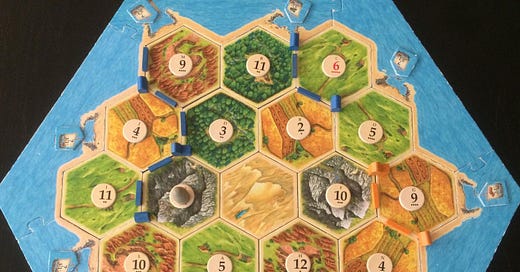





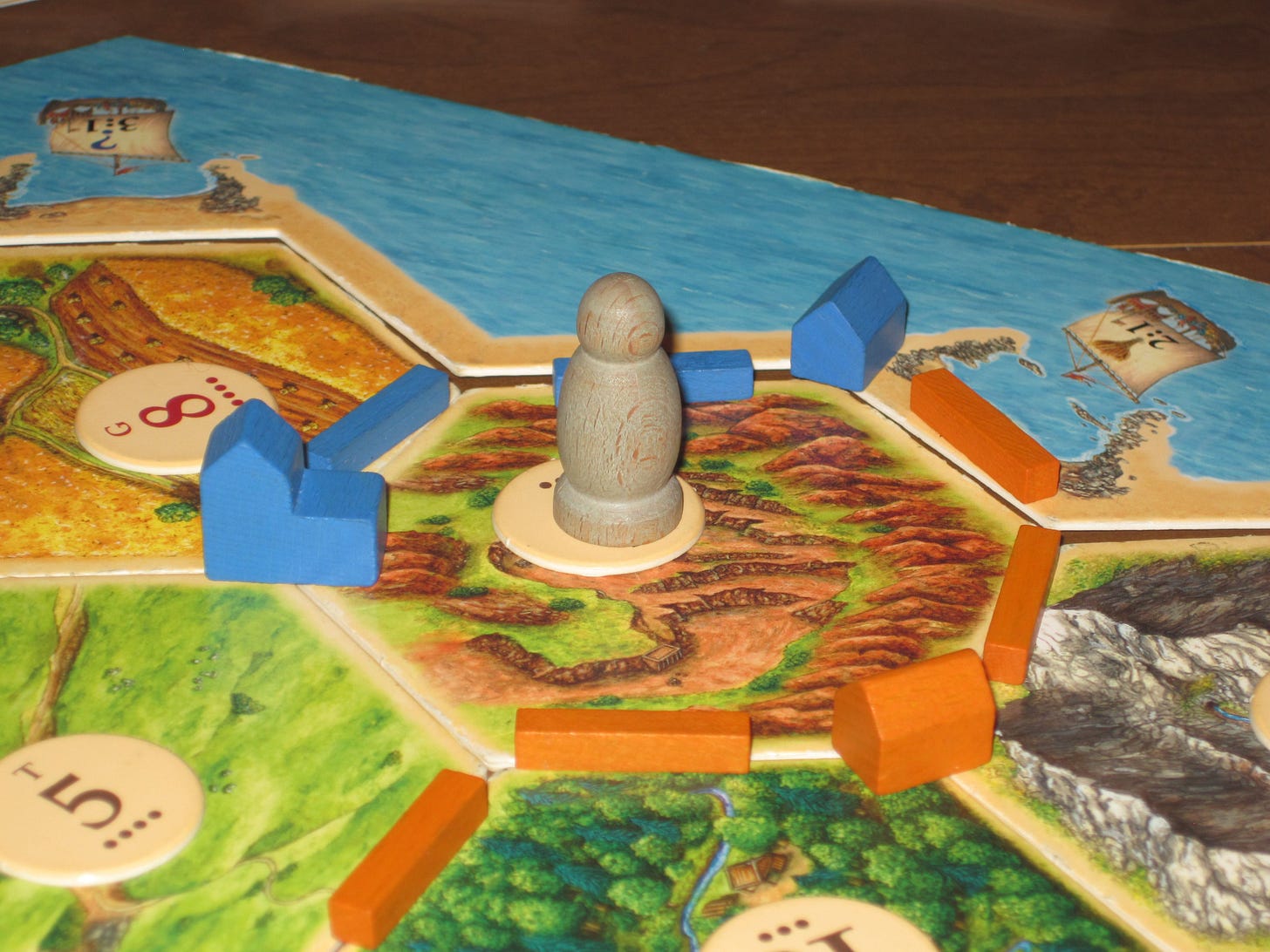
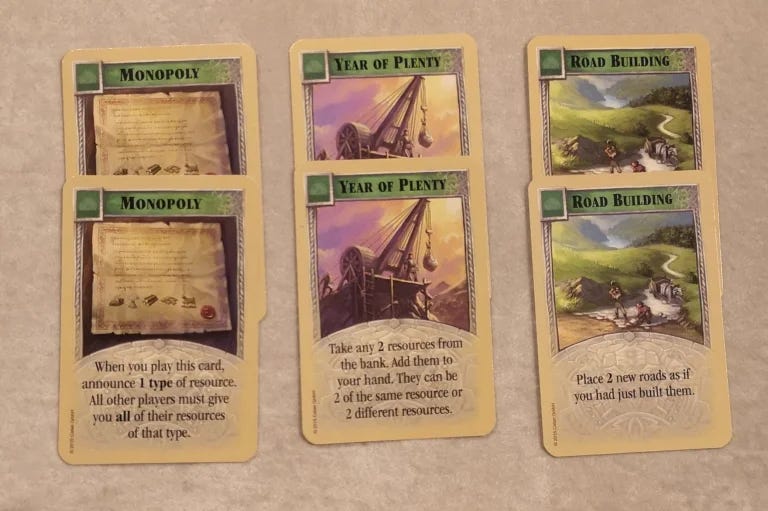
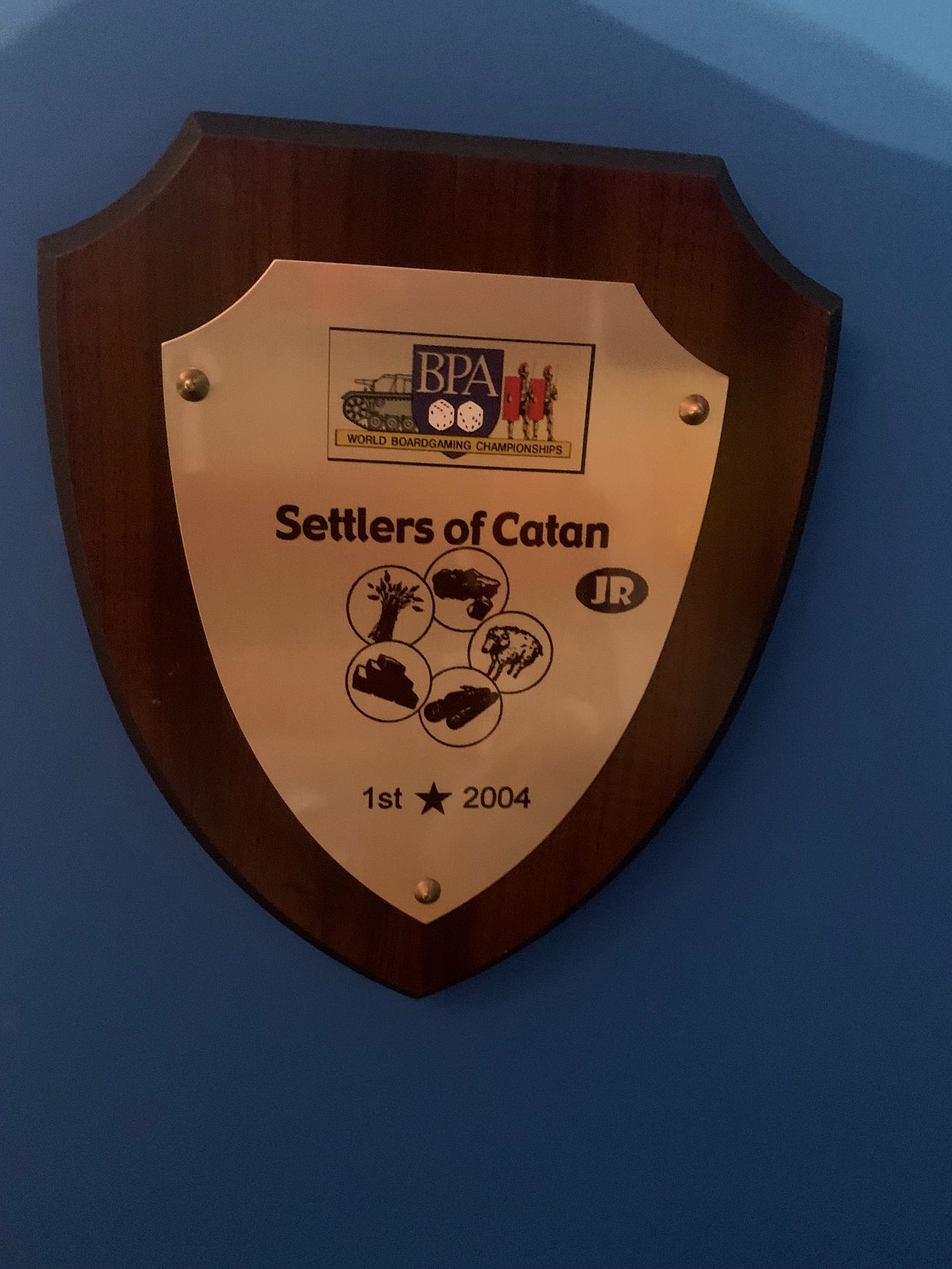

As you suggest, Catan wasn't entirely unique in variable setup (Knizia's "Tutankhamen" did that a couple years earlier, and Tom Jolly's "Wiz-War" did it a decade before that, among others), though its overlap of variable board AND variable numbers is, I think, still very much an innovation.
Likewise, there are a few other games where you can only trade with the active player; Bohnanza did this (though it came after Catan and was probably influenced by that mechanic), for example, and Traders of Genoa not only has that restriction but also takes the scope of "trading" to extremes. I also vaguely remember a very old MS-DOS game where you offered a trade as the sole action of your turn (you were offering trades of gems with other players, trying to get the largest set of a single type of gem), which probably also counts on a technicality and does pre-date Catan... though I think Catan might be the first boardgame to really popularize the mechanic.
The Development cards were definitely the most swingy (some were far better than others), though slightly more than half the deck is Army cards so going for Largest Army bonus always did seem to me like an achievable strategy (you're buying 6 cards or so on average - much more expensive than the 5 roads it takes to get the Longest Road bonus, sure, but you're also getting a lot of extra mileage out of the card effects themselves, so it doesn't feel horrendously unbalanced). I'd also say that "if they're holding a card in reserve, it's usually a point card" is probably more dependent on who you play with; I've definitely held Monopoly cards in reserve at the right moment, and also threatened (or bluffed) that my face-down card was an Army card to convince opponents to not put the Robber on me. So I think there's more nuance to the card deck than you give credit for here.
The UI of dots on the numbers that you mention was, interestingly, NOT in the original German printing by Kosmos, so it might not be fair to credit that particular thing to Teuber himself. The first printing did have the numbers 2/12 printed in a smaller font than 3/11 which was smaller than 4/10 and so on, and the 6 and 8 were red, but there were no dots; it did give a sense that some numbers were more powerful, but didn't allow players to do the math of "add up the dots on the 3 adjacent hexes to see how many resources you're expected to get." I think the dots were added pretty early (2nd edition?) though, and they were useful enough that they've stuck around.
I would say that Catan did benefit a fair bit from being in the right place at the right time, too. It's not like good Eurogames didn't exist prior to 1995 - there were decades of fantastic Spiel des Jahres winners predating Catan - but it came across to the US just as there were hobby game stores popping up everywhere to serve the hunger for Magic and other TCGs that was in full swing, so there was actually a direct-to-consumer pathway for Catan that didn't exist for, say, Hare&Tortoise, Scotland Yard, Modern Art, or Can't Stop, even though I'd say each of those deserved the same mass-market success. That said, Catan's particular blend of competition-but-with-collaboration, randomness-but-manageable, and with a sufficiently short play time, definitely set it up for strong success. And it's certainly left a heck of a legacy; as I've said elsewhere, without Catan we wouldn't have had the Eurogames explosion in the US; without that we wouldn't have had as many American designers influenced by the Euros, which means we wouldn't have Dominion, and without that we don't have the entire deckbuilder genre, nor the digital roguelite-deckbuilder genre... I'm not saying Catan is DIRECTLY responsible for all of these things, but I'm saying that of all the parallel universes out there where Catan was not invented, I suspect most of them would not have had these other things at all.
I agree with you strongly on one point and disagree with you (not so strongly) on another.
1. It is a violation of man and nature to randomize the circular tokens in a Catan board set-up. They are specifically alphabetized to avoid grossly imbalanced production among the tile vertices. Randomizing them completely undermines their underlying genius. There is a place in hell for people who do that.
2. I do not like to place the robber right on top of the number token. Invariably, two turns later, I will say, "Okay, I rolled a five. Here's one of them - you get a brick, I get a brick. Where's the other five? <scan, scan, scan> Where's the other five? Oh, wait, is it under the robber? <checks> Oh, yeah." I hate that.